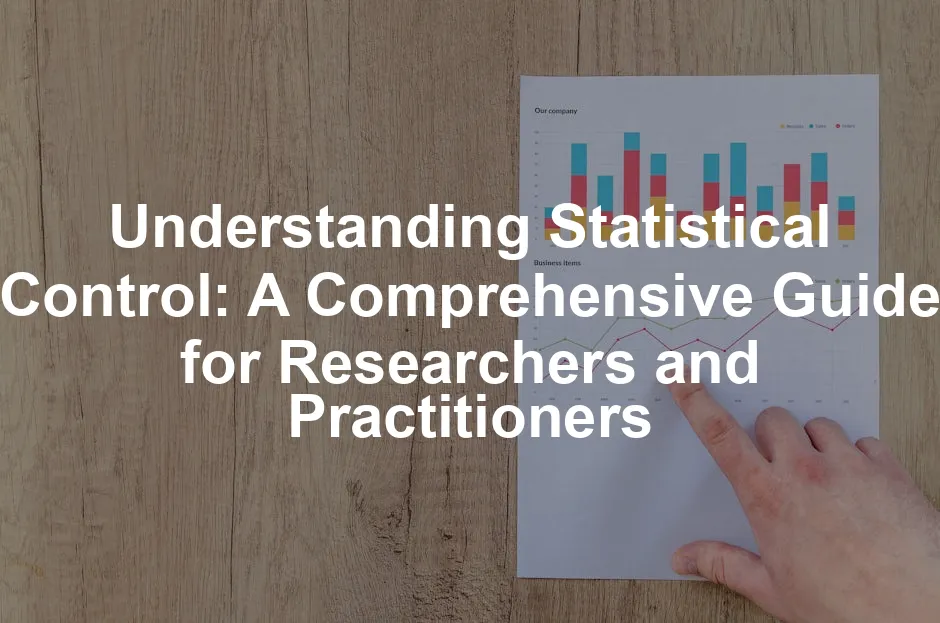Introduction
Statistical control is a vital concept in the world of data analysis and quality assurance. This method applies statistical techniques to monitor and control various processes, ensuring they operate efficiently and produce consistent results. Statistical control is pertinent across several fields, including manufacturing, healthcare, and social sciences.
Imagine you’re watching a cooking show. The chef follows a recipe, ensuring the ingredients are measured precisely. If the recipe calls for two cups of flour, adding three will ruin the dish. Similarly, statistical control helps maintain the right mix in processes, preventing deviations that lead to inferior products or outcomes.
Why bother with statistical control? It’s crucial for accuracy, consistency, and quality. In manufacturing, for instance, it helps minimize waste and defects, translating to lower costs and higher customer satisfaction. In research, it ensures that findings reflect true relationships rather than artifacts caused by external factors. Without it, we might as well be tossing a coin to decide the quality of our outcomes!
The objective of this article is to provide a thorough understanding of statistical control. We’ll explore its methods, applications, benefits, and challenges. By the end, you’ll see why statistical control is not just a set of techniques but a necessary approach for reliable results in any process.

The Foundations of Statistical Control
What is Statistical Control?
Statistical control refers to the methods used to analyze and monitor processes to ensure they run as intended. At its core, it aims to identify and manage variability within processes. This is fundamental because variability can lead to inconsistent results and, ultimately, dissatisfaction among stakeholders.
Variability is unavoidable; it’s a part of every process. However, understanding and controlling it is where the magic happens. Statistical control helps distinguish between “common cause” variation—normal fluctuations inherent in a process—and “special cause” variation, which stems from unexpected issues. This distinction is crucial for effective management.
Control limits play a significant role in statistical control. These limits define the range within which a process is considered stable. When data points fall outside these limits, it signals that something unusual is happening. Control charts, visual representations of process data, are the primary tools for monitoring these limits. They help detect trends and shifts, allowing for timely interventions. For more on control charts, check out this statistical process control control charts.
If you’re looking to implement statistical process control in your organization, consider investing in Control Chart Software. This tool can streamline your data analysis and help you monitor your processes more effectively, making it easier to maintain quality and consistency.

Understanding control charts is essential for monitoring process stability. statistical process control control charts
In summary, statistical control is a powerful ally for anyone looking to maintain quality and consistency in their processes. By understanding its foundational concepts, practitioners can better manage variability and improve outcomes across various domains.
Historical Background
Origin: Statistical control began its journey in the 1920s, thanks to the brilliant mind of Walter A. Shewhart. While working at Bell Laboratories, Shewhart introduced the first control chart in 1924. This was not just a fancy doodle; it was a groundbreaking tool designed to monitor and control quality effectively. He aimed to rationalize sampling inspection, and his ideas laid the groundwork for modern quality control practices.
Imagine the chaos of a factory without any checks. Products would be flying off the assembly line, but who knows if they meet the standards? Shewhart’s work changed that. His control charts brought order to the manufacturing madness, ensuring that processes could be stable and predictable. His innovative thinking helped industries maintain quality while minimizing waste.
Evolution: Fast forward to the mid-20th century, and we see Shewhart’s concepts gaining traction during World War II. The military realized that effective quality control was crucial for munitions and weaponry. However, after the war, interest in statistical control waned in the U.S. But wait! Japan picked up the baton. Japanese manufacturers, eager to improve quality and compete globally, embraced statistical control with open arms.
In the 1970s, statistical control made a triumphant return to the U.S. This resurgence was largely due to the influence of quality gurus like W. Edwards Deming. He championed these methods, leading to a widespread adoption of statistical control techniques across various industries. Today, it’s hard to imagine manufacturing without these essential tools. They are the unsung heroes ensuring that our products meet the quality we expect.

Types of Statistical Control
Statistical Process Control (SPC): So, what is SPC? Simply put, Statistical Process Control is a method that uses statistical techniques to monitor and control a manufacturing process. Think of it as a vigilant supervisor, constantly checking to ensure everything runs smoothly. It focuses on identifying variability in production processes and using that information to maintain product quality. For a deeper understanding of SPC, refer to our spc statistical process control definition.
SPC is essential for maintaining quality in manufacturing processes. spc statistical process control definition
SPC employs various tools, including control charts, to visualize data over time. When a process is in control, it produces consistent outcomes. When it’s not, SPC helps identify the cause, allowing for timely corrections. This proactive approach saves time and resources while enhancing overall efficiency.
Acceptance Sampling: Ever received a box of chocolates and wondered if all of them were good? That’s acceptance sampling in action! It’s a quality control method where a random sample is inspected to decide whether to accept or reject an entire batch. If the sample meets quality standards, the batch is accepted; if not, it’s rejected. This method saves time and resources by avoiding the need to inspect every single item.
Acceptance sampling is especially significant in industries where inspecting every unit is impractical. It helps maintain quality while minimizing costs, making it a popular choice for manufacturers worldwide.
Regression Analysis: Regression analysis is like a detective for researchers. It helps control for extraneous variables that could skew results. By examining the relationships between variables, researchers can isolate the effect of a specific variable while holding others constant. This is crucial for understanding true cause-and-effect relationships.
Picture it as a way to clear the clutter in your data. Instead of being overwhelmed by potential influences, regression analysis helps pinpoint what really matters. It’s an essential tool for researchers aiming to produce reliable and accurate findings in their studies. If you want to dive deeper into regression analysis, consider picking up a copy of Data Analysis Using Regression and Multilevel/Hierarchical Models. It’s a fantastic resource for anyone delving into the intricacies of statistical analysis.

Data Collection Methods
Data collection is the lifeblood of statistical control. It’s how we gather the information needed to understand and optimize processes. There are two main methods for collecting data: measurements and observations.
Measurements involve quantifying specific attributes of a process. This could mean measuring the weight of a product, the time it takes to complete a task, or even the temperature of a machine. Measurement tools like calipers, thermometers, and digital scales provide precise data that is crucial for analysis. With accurate measurements, you can create control charts, track performance, and identify variations in your processes. If you’re serious about measurements, check out this Caliper Tool for precise measurements!
Observations, on the other hand, are more qualitative. This method entails watching a process in action and noting how it performs. For example, an observer might record how employees interact with machinery or how often a machine malfunctions. While observations can be less precise than measurements, they can reveal patterns or issues that numbers alone might miss. Combining both methods often yields the best results, providing a comprehensive view of a process.

Common Statistical Control Methods
1. Regression Analysis
Regression analysis is like a crystal ball for researchers. It helps identify relationships between variables, allowing for control over potential confounding factors. By modeling these relationships, you can make informed predictions and decisions. For instance, if you’re studying the effect of a new training program on productivity, regression analysis helps isolate that effect from other influences like experience or workload.
2. Analysis of Covariance (ANCOVA)
Think of ANCOVA as a superhero combining ANOVA and regression. This method allows researchers to control for continuous confounding variables while examining group differences. For example, if you’re comparing test scores between two teaching methods, ANCOVA can adjust for prior knowledge levels, giving a clearer picture of which method works better. It’s a powerful tool for ensuring that your results accurately reflect the true impact of your variables.
3. Matched Pairs Design
Matched pairs design is like setting up a game of chess where each player has identical pieces. This method involves pairing subjects based on key characteristics to compare responses to different treatments. For instance, in a clinical trial, you might pair patients with similar health profiles, ensuring that any differences in outcomes can be attributed to the treatment rather than inherent differences. This approach enhances the validity of your findings and minimizes the influence of confounding variables.

Choosing the Right Method
When selecting a statistical control method, several factors come into play.
Research Questions: What are you trying to find out? Your question shapes your method choice. Exploratory questions might call for different methods than confirmatory ones.
Data Types: Consider whether your data is categorical or continuous. This distinction impacts which statistical tools are most suitable.
Available Resources: Assess the resources at your disposal. Some methods require specialized software or training, while others are more straightforward. If you’re looking for a comprehensive guide, consider The Lean Six Sigma Pocket Toolbook as a handy resource.
Potential Confounding Variables: Identifying and controlling for these is crucial. The more you know about what could skew your results, the better equipped you’ll be to select the right method.
By carefully weighing these factors, you can ensure that your statistical control approach aligns with your study’s goals, leading to more reliable and valid results.

Case Studies: Successful Implementation of SPC in Manufacturing
Statistical Process Control (SPC) has revolutionized manufacturing processes, ensuring quality while cutting costs. Let’s take a spin through some exciting case studies, particularly focusing on the automotive industry, where SPC shines brighter than a freshly waxed car.
In the 1980s, Toyota famously adopted SPC to enhance its production system. By utilizing control charts, they monitored every aspect of the manufacturing process. This proactive approach allowed them to identify variations early. As a result, Toyota not only minimized defects but also maximized efficiency. Who knew that a little data could lead to a lot of cars rolling off the assembly line without a hitch?
Then there’s Ford, which implemented SPC to reduce waste in its production lines. By integrating SPC techniques, they achieved a significant reduction in rework costs. Ford’s assembly lines became a model of efficiency, showcasing how precise monitoring can transform operations. Imagine the excitement in the boardroom when they realized they could save millions just by paying attention to their data!
Another noteworthy example comes from General Motors, which faced challenges with quality control in the 1990s. They turned to SPC as a solution. By applying statistical methods to monitor processes, they successfully reduced defects by 50% within a year. This not only bolstered their reputation but also improved customer satisfaction. Talk about a win-win!
These case studies illustrate the power of SPC in the automotive sector. By implementing statistical control methods, manufacturers can achieve significant improvements in quality and efficiency. So, the next time you drive a well-crafted vehicle, remember that behind the scenes, statistical control might just be the unsung hero keeping things running smoothly.

In Research
Controlling Extraneous Variables
In research design, statistical control is more than a buzzword; it’s a lifeline! It helps researchers isolate variables of interest, ensuring that their findings are not skewed by pesky extraneous variables. Imagine trying to bake a cake while someone keeps changing the oven temperature. Frustrating, right? Similarly, uncontrolled variables can lead to misleading results in research.
By implementing statistical control, researchers can hold constant various factors that may influence outcomes. This way, they can confidently claim that their results are a direct reflection of the variables they aim to study. Whether it’s a clinical trial assessing drug efficacy or a social study analyzing behavior, controlling for extraneous variables ensures the integrity of the findings.
For those diving deep into research methodologies, consider picking up Introduction to Statistical Quality Control by Douglas C. Montgomery. It’s a fantastic resource for understanding quality control in research.

Real-World Examples
Let’s look at some real-world examples highlighting statistical control’s significance across various fields. In healthcare, the Framingham Heart Study stands out. By controlling for variables like age, gender, and lifestyle, researchers identified critical risk factors for heart disease. This research has influenced public health strategies worldwide. For more on healthcare statistics, see our article on healthcare workplace violence statistics virginia.
The Framingham Heart Study is a prime example of controlling variables in healthcare research. healthcare workplace violence statistics virginia
In the social sciences, consider a study on the impact of educational interventions. Researchers controlled for socioeconomic status and prior academic performance, allowing them to isolate the intervention’s effects. This meticulous approach led to actionable insights on improving educational outcomes.
These examples underscore the importance of statistical control in research. By isolating variables of interest, researchers can draw meaningful conclusions, ultimately contributing to knowledge advancement across fields.

In Service Industries
Application in Services
Statistical control isn’t just for manufacturing; it’s making waves in service industries too! Imagine waiting for your favorite coffee at a bustling café. You expect consistency, right? That’s where statistical control comes in, optimizing service delivery and enhancing customer satisfaction.
Take, for instance, a popular fast-food chain. By implementing SPC techniques, they monitor service times and order accuracy. This data-driven approach helps identify bottlenecks and inefficiencies. As a result, customers receive their orders faster and more accurately, leading to happier faces and repeat business.
In the healthcare sector, hospitals apply statistical control to improve patient care. By analyzing patient wait times and treatment outcomes, healthcare providers can pinpoint areas for improvement. This not only enhances service quality but also boosts patient satisfaction. After all, who wants to spend hours in a waiting room?
In summary, statistical control is a powerful tool in service industries. By optimizing processes and ensuring high-quality service delivery, businesses can elevate customer experiences and foster loyalty. So the next time you enjoy a quick bite or a doctor’s visit, remember that behind the scenes, statistical control is working its magic!

Ethical Considerations
Transparency and Integrity
In the world of statistical control, ethical considerations are paramount. Transparency isn’t just a buzzword; it’s the backbone of trust in statistical methodologies. When researchers and practitioners apply statistical control methods, they must openly share their processes, data sources, and analytical techniques. This openness allows others to replicate studies, ensuring that results are not just a fluke but a reflection of reality.
Integrity plays a crucial role as well. Misusing data or manipulating results can lead to severe consequences. Imagine a chef who secretly substitutes ingredients to make a dish look better. That’s not just unethical; it’s misleading! In statistical control, failing to maintain integrity can skew findings and ultimately harm decision-making processes. Researchers must remain committed to honest reporting, ensuring that their work contributes positively to their field.

Best Practices
To ensure ethical use of statistical control techniques, practitioners should adopt several best practices. First, implementing a clear protocol for data collection and analysis is essential. This protocol should outline steps for handling data responsibly, ensuring that it is accurate and representative.
Second, fostering a culture of peer review can enhance the credibility of findings. By inviting colleagues to evaluate methodologies and results, practitioners can catch potential biases or errors before they affect conclusions.
Third, avoiding selective reporting of results is critical. Presenting only favorable outcomes can paint a misleading picture. Instead, researchers should report all findings, regardless of whether they support the initial hypothesis.
Lastly, engaging in continuous ethical education can help practitioners stay informed about best practices and emerging ethical dilemmas in statistical control. This ongoing learning fosters an environment where integrity and transparency are valued, ultimately leading to better research outcomes and a more trustworthy scientific community.
By adhering to these ethical guidelines, those involved in statistical control can contribute meaningfully to their fields while upholding the highest standards of integrity and transparency.
Please let us know what you think about our content by leaving a comment down below!
Thank you for reading till here 🙂
All images from Pexels




